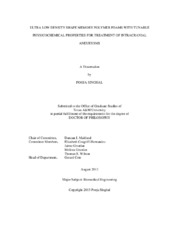| dc.contributor.advisor | Maitland, Duncan J | |
| dc.creator | Singhal, Pooja | |
| dc.date.accessioned | 2016-09-22T19:38:22Z | |
| dc.date.available | 2016-09-22T19:38:22Z | |
| dc.date.created | 2013-08 | |
| dc.date.issued | 2013-05-29 | |
| dc.date.submitted | August 2013 | |
| dc.identifier.uri | https://hdl.handle.net/1969.1/157912 | |
| dc.description.abstract | Shape memory polymers (SMPs) are a rapidly emerging class of smart materials that can be stored in a deformed temporary shape, and can actively return to their original shape upon application of an external stimulus such as heat, pH or light. This behavior is particularly advantageous for minimally invasive biomedical applications comprising embolic and regenerative scaffolds, as it enables a transcatheter delivery of the device to the target site. The focus of this work was to exploit this shape memory behavior of polyurethanes, and develop an efficient embolic SMP foam device for the treatment of intracranial aneurysms.
The first step herein was to achieve ultra low density foams with a highly covalently crosslinked polymer structure to enable good mechanical properties and shape memory behavior, while ensuring a high filling efficiency of the device. Favorable results of densities down to 0.015 g·cm-3 were attained with excellent shape memory of 98-99% recovery and up to 70 times volume expansion on actuation for these materials. However, these materials showed premature actuation on exposure to water/physiological media during delivery through a microcatheter. This hindered the device delivery, and inspired a new series of materials with controlled hydrophobicity. Successful transcatheter delivery has since been conducted with these materials. Additional optimization of the foam formulation and synthesis process produced still lower densities of down to 0.008 g·cm-3 providing a further improved embolic efficiency. Also, plasma treatment of the foams was identified as a viable and efficient technique for achieving complete reticulation of these materials, important for moderating the permeability of the device. Finally, low molecular weight ester based monomers were introduced in the foams to achieve controlled device degradation and avoid long presence of a foreign material in the body.
In summary, this work reports a novel family of ultra low density polymer foams which can be delivered via a minimally invasive surgery to the aneurysm site, actuated in a controlled manner to efficiently embolize the aneurysm while promoting physiological fluid/blood flow through the reticulated/open porous structure, and eventually biodegrade leading to complete healing of the vasculature. | en |
| dc.format.mimetype | application/pdf | |
| dc.language.iso | en | |
| dc.subject | Shape Memory | en |
| dc.subject | Foams | en |
| dc.subject | Biomedical Device | en |
| dc.subject | Biomaterials | en |
| dc.title | Ultra Low Density Shape Memory Polymer Foams with Tunable Physicochemical Properties for Treatment of Intracranial Aneurysms | en |
| dc.type | Thesis | en |
| thesis.degree.department | Biomedical Engineering | en |
| thesis.degree.discipline | Biomedical Engineering | en |
| thesis.degree.grantor | Texas A & M University | en |
| thesis.degree.name | Doctor of Engineering | en |
| thesis.degree.level | Doctoral | en |
| dc.contributor.committeeMember | Wilson, Thomas S | |
| dc.contributor.committeeMember | Cosgriff-Hernandez, Elizabeth | |
| dc.contributor.committeeMember | Grunlan, Jaime | |
| dc.contributor.committeeMember | Grunlan, Melissa | |
| dc.type.material | text | en |
| dc.date.updated | 2016-09-22T19:38:22Z | |


